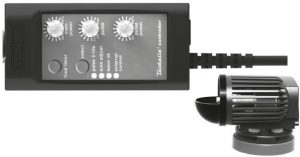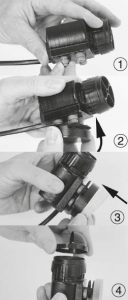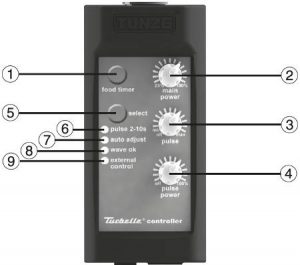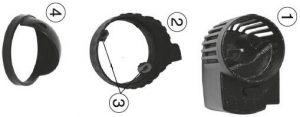
View On Amazon
| Size | Dimensions | Tank Size | Noise Level | Longevity | Price |
| 53-1188 GPH | 2.5″ x 2.5″ x 2.5″ | 5-132 Gallons | Low | 6-15+ Years | High |
The Tunze 6040 powerhead and controller combo gives you complete control over the water flow in your tank. It can push anywhere between 53 and 1188 GPH, using either consistent flow or pulses for a wave maker set-up. Using the pulse mode does make the powerhead more audible, breaking the usual silence Tunze powerheads bring with them.
The power draw can be anywhere between 1.5 and 13 watts depending on the strength the Tunze is set to. Given the lifetime and control this combo gives, it is well worth the cost.
Set-up

Setting up the Tunze is as easy as you choose to make it. First you will need to connect the four blue rubber connectors to the base of the powerhead. These are excellent noise dampeners which allow high flow with almost no sound. With the four connectors in place you will press the powerhead into place on the internal magnet. Simply line them up and push the connectors into place.
Next you will need to choose the color of magnet protector you want. The two choices are Tunze blue and a hard to notice grey. These both reduce the noise level further by adding a layer between the magnet and glass. The color is purely for aesthetics.
The second to last step is to attach the deflector head. This turns the water flow at a 90 degree angle and focuses the flow. Because the powerhead’s direction is not adjustable without the deflector head few tanks can go without it.
With everything installed you can begin the dangerous part. Magnets. Tunze uses powerful magnets to secure their powerheads, which when handled carelessly can lead to serious issues. Never put yourself between the two magnets. They can easily clamp onto your hand. If this happens you will be unable to remove the magnets by yourself while they continuously exert plenty of force on your hand. Do not play with these magnets, they are not toys. Additionally do not let them touch one another, as they are very difficult to separate. If this does happen refer to the section at the bottom of this page.
Hold the interior magnet in place and slowly bring the exterior magnet to the glass outside of the aquarium. This is best done by placing the exterior magnet above its final resting spot, sliding it down into place. This prevents the magnets from lunging together, which can crack or even shatter the aquariums glass walls. Be sure to use a firm grip on both magnets while doing this.
The power cord from the controller to the powerhead is 2 meters long, about 6.5 feet, which means you can place the Tunze 6040 just about anywhere you want.
With the powerhead in place we will move on to using the controller.
Using The Controller

- 1: Food Timer
This button will trigger a 10 minute feeding period, during which the powerhead will switch off. After the 10 minutes has ended the powerhead will resume normal operation.
- 2: Main Power Control
This knob will control the speed of the powerhead, which can be set anywhere between 20% to 100%.
- 3: Pulse Control Knob
This knob will choose how long the pulse duration are and time between pulses. The knob can be turned all the way to the left to remove pulses entirely, leaving only constant power. The flow rate will then only depend on the main power knob.
- 4: Pulse Power
This knob will control how strong the pulses are. Additionally if the night mode attachment is added onto the controller this is the speed the powerhead will use for the night. It can be set anywhere between 0-100%
- 5: Select
This button will select one of the modes shown below the select button.
- 6: Pulse Mode
This will emit pulses of water within the range of 2-10 seconds and is adjusted by the second knob, labeled 3.
- 7: Auto Adjust
This mode adjusts itself to find the perfect resonance frequency. Generally this creates a perfect standing wave without any adjustments.
- 8: Wave Ok
This mode will briefly pause auto adjust. The pulse frequency can then be fine tuned with the control knob.
- 9: External Controller
This mode is required to connect a multi controller or when connecting to another Tunze controller. If this mode is selected and no external controller is connected or the external controller is not providing any signal the powerhead will switch off. The powerhead can however still be adjusted using the main power knob to specify a maximum power. This is not true with the pulse knob.
Assembly

The Tunze 6040 is designed quite differently than most Tunze powerheads are. Rather than the ball in a u shaped mount it is simply a cylinder mounted directly on the magnet. This drastically limits the angular control of the powerhead, but also reduces the size of the powerhead. An excellent trade for smaller tanks, but with the 1188 GPH potential on this powerhead it is a questionable tradeoff.
The front mounted grate comes off of the main body via the two clips on the side. Once removed you will have access to the propeller, which can also be removed to clean out the propellers mount. Both the propeller and mount must be cleaned using soft, non abrasive materials. Any scratches to these parts will cause irregular spinning, increased noise and a shortened lifetime.
For the best results you should clean out your powerhead every month or two. Tunze themselves highly recommend that their powerheads should be deep cleaned every three months, especially in tanks with high calcium or lime concentrations. These two can cause strong build ups, which will add resistance to the powerheads motor. This can cause extra heat, reduced power and again shorten the life of the powerhead.
A quick note about cleaning: the front grate has no cover, meaning fish can easily enter the powerhead when it is not on. Always check the powerhead before starting it up to ensure no fish or inverts are peeking inside.
Because this model is designed for use with a controller it has been made with DC current rather than AC. This prevents any reverse running and start up noises.
The noise level will start out a bit louder than expected, as the Propeller will need to align properly. This should be resolved in a matter of hours.
The thick power supply block protects the powerhead from both short circuits and thermal overloads. This is certainly good for putting our minds at ease but it can take up a bit of extra space on our power strips.
A final note here is the auto shut off feature installed on the Tunze 6040. If the powerhead for whatever reason cannot start or is running out of the water column it will shut off automatically. Unplug the powerhead and resolve the issue. Once fixed the powerhead will attempt to restart after a 20 second delay.
Warranty & Lifetime
All Tunze powerheads come with a two year warranty. During this time Tunze will either replace or repair any damaged/faulty powerheads or components. Their customer service agents are all friendly and quick to answer any calls. Most Tunze owners will tell you how the warranty is never needed.
The lifetime on Tunze 6040 is even longer than most Tunze’s, which is really saying something. The DC that prevents reverse running also reduces stress on the propeller and therefore motor. These are the main two sources of failure. All in all most owners will see over a decade of use, with the solid number range being 6+ years. Those who do manage to see only six years are owners who refuse to clean out their powerheads. It only takes 5 minutes a month to get an extra 10 years of use out of this powerhead.
Separating Magnets
For people like me who don’t pay attention to the giant warning printed on the back of the magnet, here’s a quick and easy way to separate the magnets. First you will need to take the magnets to a straight edged surface, one that can handle a lot of force. Place the magnets so that one is on the edge while the other is only held in place by the other magnet.
Push down on the hanging magnet while holding the other in place. This will take a fair amount of force, but certainly not more than anyone can provide by just using their weight. The magnets will slide apart, after which you must be careful that they do not snap back together or grab onto anything else.
The reason this works is because it is much easier to separate magnets horizontally. Pulling them apart is near impossible, as there is no where near enough space to get a solid grip. These magnets have over 50 lbs of force holding them together. The last thing I recommend is trying to pull them apart, which will put your fingers right between the two magnets if you manage to do it.